
Mushroom hunting, mushrooming, mushroom picking, mushroom foraging, and similar terms describe the activity of gathering mushrooms in the wild. This is typically done for culinary use, although medicinal and psychotropic uses are also known. This practice is popular throughout most of Europe, Australia, Asia, as well as in the temperate regions of Canada and the United States.

Coprinus comatus, commonly known as the shaggy ink cap, lawyer's wig, or shaggy mane, is a common fungus often seen growing on lawns, along gravel roads and waste areas. The young fruit bodies first appear as white cylinders emerging from the ground, then the bell-shaped caps open out. The caps are white, and covered with scales—this is the origin of the common names of the fungus. The gills beneath the cap are white, then pink, then turn black and deliquesce ('melt') into a black liquid filled with spores. This mushroom is unusual because it will turn black and dissolve itself in a matter of hours after being picked or depositing spores.

Entoloma sinuatum is a poisonous mushroom found across Europe and North America. Some guidebooks refer to it by its older scientific names of Entoloma lividum or Rhodophyllus sinuatus. The largest mushroom of the genus of pink-spored fungi known as Entoloma, it is also the type species. Appearing in late summer and autumn, fruit bodies are found in deciduous woodlands on clay or chalky soils, or nearby parklands, sometimes in the form of fairy rings. Solid in shape, they resemble members of the genus Tricholoma. The ivory to light grey-brown cap is up to 20 cm (7.9 in) across with a margin that is rolled inward. The sinuate gills are pale and often yellowish, becoming pink as the spores develop. The thick whitish stem has no ring.

Paxillus involutus, commonly known as the brown roll-rim, common roll-rim is a basidiomycete fungus that is widely distributed across the Northern Hemisphere. It has been inadvertently introduced to Australia, New Zealand, South Africa, and South America, probably transported in soil with European trees. Various shades of brown in colour, the fruit body grows up to 6 cm high and has a funnel-shaped cap up to 12 cm wide with a distinctive inrolled rim and decurrent gills that may be pore-like close to the stipe. Although it has gills, it is more closely related to the pored boletes than to typical gilled mushrooms. It was first described by Pierre Bulliard in 1785, and was given its current binomial name by Elias Magnus Fries in 1838. Genetic testing suggests that Paxillus involutus may be a species complex rather than a single species.
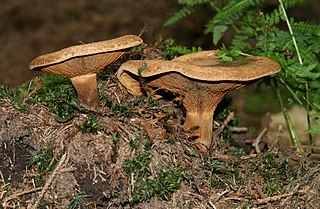
Paxillus is a genus of mushrooms of which most are known to be poisonous or inedible. Species include Paxillus involutus and Paxillus vernalis. Two former species—Tapinella panuoides and Tapinella atrotomentosa—have now been transferred to the related genus Tapinella in the family Tapinellaceae

Amanita cokeri, commonly known as Coker's amanita and solitary lepidella, is a poisonous mushroom in the family Amanitaceae. First described as Lepidella cokeri in 1928, it was transferred to the genus Amanita in 1940.

Hygrophoropsis aurantiaca, commonly known as the false chanterelle, is a species of fungus in the family Hygrophoropsidaceae. It is found across several continents, growing in woodland and heathland, and sometimes on woodchips used in gardening and landscaping. Fruit bodies (mushrooms) are yellow–orange, with a funnel-shaped cap up to 8 cm across that has a felt-like surface. The thin, often forked gills on the underside of the cap run partway down the length of the otherwise smooth stipe. Reports on the mushroom's edibility vary – it is considered poisonous, but has historically been eaten in parts of Europe and the Americas.

Tapinella atrotomentosa, commonly known as the velvet roll-rim or velvet-footed pax, is a species of fungus in the family Tapinellaceae. Although it has gills, it is a member of the pored mushroom order Boletales. August Batsch described the species in 1783. It has been recorded from Asia, Central America, Europe and North America. Tough and inedible, it grows on tree stumps of conifers. The mushroom contains several compounds that act as deterrents of feeding by insects.

Agaricus campestris is a widely eaten gilled mushroom closely related to the cultivated A. bisporus. A. campestris is commonly known as the field mushroom or, in North America, meadow mushroom.
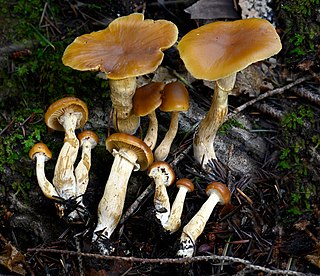
Galerina marginata, known colloquially as funeral bell, deadly skullcap, autumn skullcap or deadly galerina, is a species of extremely poisonous mushroom-forming fungus in the family Hymenogastraceae of the order Agaricales. It contains the same deadly amatoxins found in the death cap. Ingestion in toxic amounts causes severe liver damage with vomiting, diarrhea, hypothermia, and eventual death if not treated rapidly. About ten poisonings have been attributed to the species now grouped as G. marginata over the last century.

Cortinarius caperatus is an edible mushroom of the genus Cortinarius found in northern regions of Europe and North America. It was known as Rozites caperata for many years before genetic studies revealed that it belonged to the genus Cortinarius. The fruit bodies appear in autumn in coniferous and beech woods as well as heathlands in late summer and autumn. The ochre-coloured cap is up to 10 cm (4 in) across and has a fibrous surface. The clay-colored gills are attached to the stipe under the cap, and the stipe is whitish with a whitish ring. The Latin specific name, caperatus, means wrinkled, and refers to the distinctive texture of the cap. The flesh has a mild smell and flavor.

Alexander Hanchett Smith was an American mycologist known for his extensive contributions to the taxonomy and phylogeny of the higher fungi, especially the agarics.

Coprinellus disseminatus, formerly known as Coprinus disseminatus and commonly known as the fairy inkcap, fairy bonnet, or trooping crumble cap, is a species of agaric fungus in the family Psathyrellaceae. Unlike most other coprinoid mushrooms, C. disseminatus does not dissolve into black ink (deliquesce) in maturity. The species was given its current name in 1939 by Jakob Emanuel Lange.
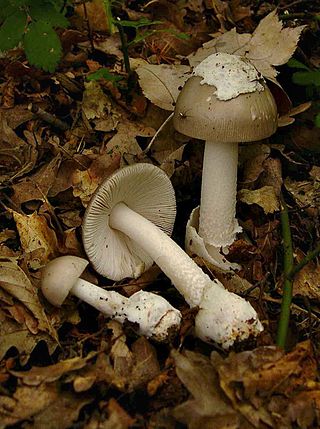
Amanita vaginata, commonly known as the grisette or the grisette amanita, is an edible mushroom in the fungus family Amanitaceae. The cap is gray or brownish, 5 to 10 centimetres in diameter, and has furrows around the edge that duplicate the gill pattern underneath. Unlike many other Amanita mushrooms, A. vaginata lacks a ring on the stem.
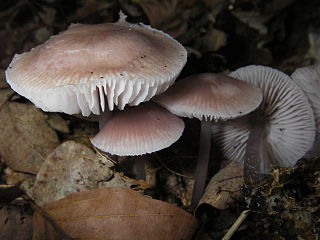
Mycena pura, commonly known as the lilac mycena, lilac bonnet, is a species of mushroom in the family Mycenaceae. First called Agaricus prunus in 1794 by Christian Hendrik Persoon, it was assigned its current name in 1871 by German Paul Kummer. Mycena pura is known to bioaccumulate the element boron.

Hypomyces chrysospermus, the bolete eater, is a parasitic ascomycete fungus that grows on bolete mushrooms, turning the afflicted host a whitish, golden yellow, or tan color. It is found in Eurasia and North America, as well as southwest Western Australia.
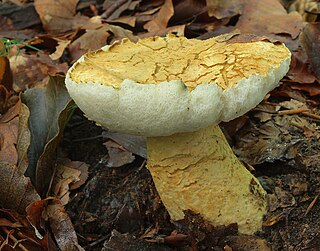
Gyroporus cyanescens, commonly known as the bluing bolete or the cornflower bolete, is a species of bolete fungus in the family Gyroporaceae. First described from France in 1788, the species is found in Asia, Australia, Europe, and eastern North America, where it grows on the ground in coniferous and mixed forests.
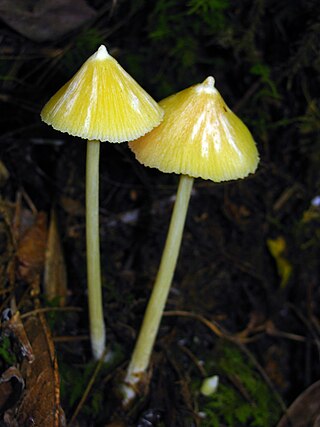
Entoloma murrayi, commonly known as the yellow unicorn Entoloma or the unicorn pinkgill, is a species of fungus in the Entolomataceae family. First described from New England (USA) in 1859, the species is found in eastern North America, Central and South America, and southeast Asia, where it grows on the ground in wet coniferous and deciduous forests. The fungus produces yellow mushrooms that have a characteristic sharp umbo on the top of a conical cap. The mushroom is inedible and may be poisonous. Other similar species can be distinguished from E. murrayi by differences in color, morphology, or microscopic characteristics.

Austropaxillus infundibuliformis is a species of fungus in the family Serpulaceae. A mycorrhizal species, it grows in the eucalypt forests of southeastern Australia. It is readily recognised by its tawny yellow colour, large size and forked decurrent gills.

Amanita excelsa, also known as the European false blushing amanita, is a species of agaric fungus in the family Amanitaceae. It is found in Asia, Europe, and North America, where it grows in deciduous forests.




















